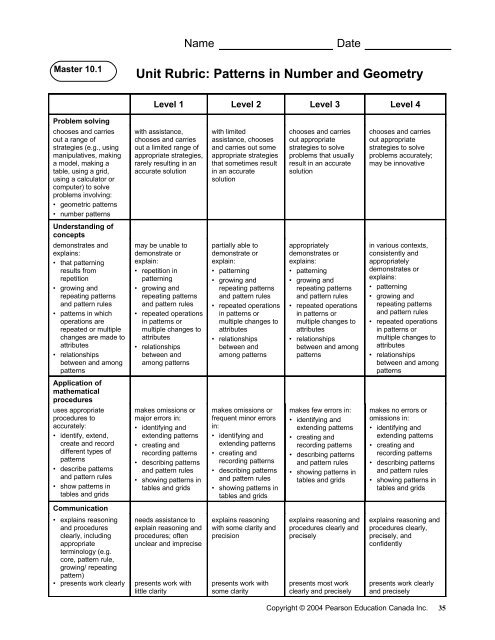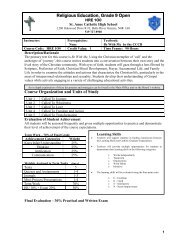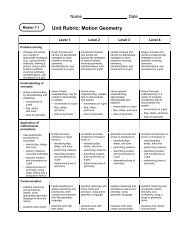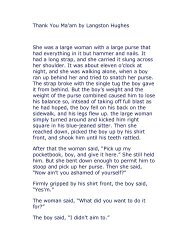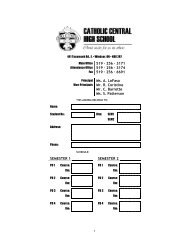Unit Rubric: Patterns in Number and Geometry
Unit Rubric: Patterns in Number and Geometry
Unit Rubric: Patterns in Number and Geometry
You also want an ePaper? Increase the reach of your titles
YUMPU automatically turns print PDFs into web optimized ePapers that Google loves.
NameDateMaster 10.1<strong>Unit</strong> <strong>Rubric</strong>: <strong>Patterns</strong> <strong>in</strong> <strong>Number</strong> <strong>and</strong> <strong>Geometry</strong>Level 1 Level 2 Level 3 Level 4Problem solv<strong>in</strong>gchooses <strong>and</strong> carriesout a range ofstrategies (e.g., us<strong>in</strong>gmanipulatives, mak<strong>in</strong>ga model, mak<strong>in</strong>g atable, us<strong>in</strong>g a grid,us<strong>in</strong>g a calculator orcomputer) to solveproblems <strong>in</strong>volv<strong>in</strong>g:• geometric patterns• number patternswith assistance,chooses <strong>and</strong> carriesout a limited range ofappropriate strategies,rarely result<strong>in</strong>g <strong>in</strong> anaccurate solutionwith limitedassistance, chooses<strong>and</strong> carries out someappropriate strategiesthat sometimes result<strong>in</strong> an accuratesolutionchooses <strong>and</strong> carriesout appropriatestrategies to solveproblems that usuallyresult <strong>in</strong> an accuratesolutionchooses <strong>and</strong> carriesout appropriatestrategies to solveproblems accurately;may be <strong>in</strong>novativeUnderst<strong>and</strong><strong>in</strong>g ofconceptsdemonstrates <strong>and</strong>expla<strong>in</strong>s:• that pattern<strong>in</strong>gresults fromrepetition• grow<strong>in</strong>g <strong>and</strong>repeat<strong>in</strong>g patterns<strong>and</strong> pattern rules• patterns <strong>in</strong> whichoperations arerepeated or multiplechanges are made toattributes• relationshipsbetween <strong>and</strong> amongpatternsmay be unable todemonstrate orexpla<strong>in</strong>:• repetition <strong>in</strong>pattern<strong>in</strong>g• grow<strong>in</strong>g <strong>and</strong>repeat<strong>in</strong>g patterns<strong>and</strong> pattern rules• repeated operations<strong>in</strong> patterns ormultiple changes toattributes• relationshipsbetween <strong>and</strong>among patternspartially able todemonstrate orexpla<strong>in</strong>:• pattern<strong>in</strong>g• grow<strong>in</strong>g <strong>and</strong>repeat<strong>in</strong>g patterns<strong>and</strong> pattern rules• repeated operations<strong>in</strong> patterns ormultiple changes toattributes• relationshipsbetween <strong>and</strong>among patternsappropriatelydemonstrates orexpla<strong>in</strong>s:• pattern<strong>in</strong>g• grow<strong>in</strong>g <strong>and</strong>repeat<strong>in</strong>g patterns<strong>and</strong> pattern rules• repeated operations<strong>in</strong> patterns ormultiple changes toattributes• relationshipsbetween <strong>and</strong> amongpatterns<strong>in</strong> various contexts,consistently <strong>and</strong>appropriatelydemonstrates orexpla<strong>in</strong>s:• pattern<strong>in</strong>g• grow<strong>in</strong>g <strong>and</strong>repeat<strong>in</strong>g patterns<strong>and</strong> pattern rules• repeated operations<strong>in</strong> patterns ormultiple changes toattributes• relationshipsbetween <strong>and</strong> amongpatternsApplication ofmathematicalproceduresuses appropriateprocedures toaccurately:• identify, extend,create <strong>and</strong> recorddifferent types ofpatterns• describe patterns<strong>and</strong> pattern rules• show patterns <strong>in</strong>tables <strong>and</strong> gridsmakes omissions ormajor errors <strong>in</strong>:• identify<strong>in</strong>g <strong>and</strong>extend<strong>in</strong>g patterns• creat<strong>in</strong>g <strong>and</strong>record<strong>in</strong>g patterns• describ<strong>in</strong>g patterns<strong>and</strong> pattern rules• show<strong>in</strong>g patterns <strong>in</strong>tables <strong>and</strong> gridsmakes omissions orfrequent m<strong>in</strong>or errors<strong>in</strong>:• identify<strong>in</strong>g <strong>and</strong>extend<strong>in</strong>g patterns• creat<strong>in</strong>g <strong>and</strong>record<strong>in</strong>g patterns• describ<strong>in</strong>g patterns<strong>and</strong> pattern rules• show<strong>in</strong>g patterns <strong>in</strong>tables <strong>and</strong> gridsmakes few errors <strong>in</strong>:• identify<strong>in</strong>g <strong>and</strong>extend<strong>in</strong>g patterns• creat<strong>in</strong>g <strong>and</strong>record<strong>in</strong>g patterns• describ<strong>in</strong>g patterns<strong>and</strong> pattern rules• show<strong>in</strong>g patterns <strong>in</strong>tables <strong>and</strong> gridsmakes no errors oromissions <strong>in</strong>:• identify<strong>in</strong>g <strong>and</strong>extend<strong>in</strong>g patterns• creat<strong>in</strong>g <strong>and</strong>record<strong>in</strong>g patterns• describ<strong>in</strong>g patterns<strong>and</strong> pattern rules• show<strong>in</strong>g patterns <strong>in</strong>tables <strong>and</strong> gridsCommunication• expla<strong>in</strong>s reason<strong>in</strong>g<strong>and</strong> proceduresclearly, <strong>in</strong>clud<strong>in</strong>gappropriateterm<strong>in</strong>ology (e.g.core, pattern rule,grow<strong>in</strong>g/ repeat<strong>in</strong>gpattern)• presents work clearlyneeds assistance toexpla<strong>in</strong> reason<strong>in</strong>g <strong>and</strong>procedures; oftenunclear <strong>and</strong> imprecisepresents work withlittle clarityexpla<strong>in</strong>s reason<strong>in</strong>gwith some clarity <strong>and</strong>precisionpresents work withsome clarityexpla<strong>in</strong>s reason<strong>in</strong>g <strong>and</strong>procedures clearly <strong>and</strong>preciselypresents most workclearly <strong>and</strong> preciselyexpla<strong>in</strong>s reason<strong>in</strong>g <strong>and</strong>procedures clearly,precisely, <strong>and</strong>confidentlypresents work clearly<strong>and</strong> preciselyCopyright © 2004 Pearson Education Canada Inc. 35
NameDateMaster 10.10Step-by-Step 1Lesson 1, Question 6Step 1Cont<strong>in</strong>ue the pattern. Add 2 each time.2, 4, ___, ___, ___, ___What is the pattern rule?_______________________________________________________Step 2Cont<strong>in</strong>ue the pattern. The number you add goes up by 1 each time.2, 4, ___, ___, ___, ___What is the pattern rule?_______________________________________________________Step 3Cont<strong>in</strong>ue the pattern. Use a calculator. Multiply by 2 each time.2, 4, ___, ___, ___, ___What is the pattern rule?_______________________________________________________Step 4Cont<strong>in</strong>ue the pattern. Choose a different way.2, 4, ___, ___, ___, ___What is the pattern rule?_______________________________________________________NameDateMaster 10.11Step-by-Step 236Copyright © 2004 Pearson Education Canada Inc.
Lesson 2, Question 4Step 1What is the pattern rule for the “In” row?_______________________________________________________Step 2What is the pattern rule for the “Out” row?_______________________________________________________Step 3Extend each pattern. Fill <strong>in</strong> the table.In 2 3 4 5Out 6 7 8 9Step 4When the “In” number is 6, what is the “Out” number? __________Step 5When the “Out” number is 12, what is the “In” number? _________NameDateMaster 10.12Step-by-Step 3Lesson 3, Question 7Use Colour Tiles.Here are the first 3 frames <strong>in</strong> a grow<strong>in</strong>g pattern.Copyright © 2004 Pearson Education Canada Inc. 37
Step 1Make Frame 4. Sketch the frame.Step 2Make Frame 5. Sketch the frame.Step 3Write about your pattern. How does it grow?_____________________________________________________________________________________________________________________________________________________________________NameDateMaster 10.13Step-by-Step 5Lesson 5, Question 6Use Attribute Blocks or Pattern Blocks.Step 1Step 2Choose 2 different blocks.Get 6 of each block.Choose 2 different attributes. ________________________________Make a pattern where these attributes change.Draw pictures to record your pattern.38Copyright © 2004 Pearson Education Canada Inc.
Write about your pattern. ___________________________________________________________________________________________Step 3Use the same blocks.Make a different pattern where two attributes change.Draw pictures to record your pattern.Write about your pattern. ___________________________________________________________________________________________NameDateMaster 10.14Step-by-Step 6Lesson 6, Question 4Use Attribute Blocks.Step 1Step 2Choose 3 different blocks. Take 4 of each block.Make a pattern.Draw pictures to record your pattern.Write about your pattern.What is the pattern rule?Copyright © 2004 Pearson Education Canada Inc. 39
Step 3Use the same blocks. Make a different pattern.Draw pictures to record your pattern.Write about your pattern.What is the pattern rule?Step 4Use the same blocks. Make another different pattern.Draw pictures to record your pattern.Write about your pattern.What is the pattern rule?NameDateMaster 10.15Step-by-Step 7Lesson 7, Question 4Use 2-cm grid paper.Step 1Draw 4 different pictures below.Step 2Repeat these pictures on a grid.Keep the order the same.40Make a pattern.Copyright © 2004 Pearson Education Canada Inc.
Step 3Look at the rows <strong>in</strong> your pattern.In which rows are the patterns the same? _______________________Step 4Look at the columns.In which columns are the patterns the same? ___________________Step 5Write about your pattern.____________________________________________________________________________________________________________________________________________________________________________________________________________Copyright © 2004 Pearson Education Canada Inc. 41


